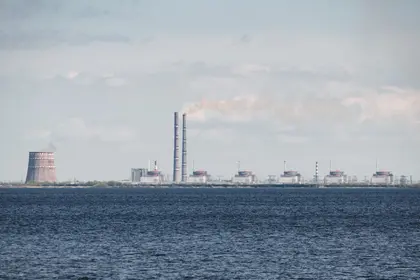We enter Nikopol by car around 5 p.m. Everything is closed. A few people are sauntering through the streets and the occasional bus goes by. Of all the cities we have visited, this is probably the emptiest.
Nikopol is located on the right bank of the Dnipro River in the Dnipropetrovsk region. On the other side is the Zaporizhzhia region and the city of Enerhodar, home to the Zaporizhzhia Nuclear Power Plant. The site was captured by the Russians in early March and its six reactors are visible from the embankment. It is from Enerhodar that enemy shells fly towards Nikopol.
JOIN US ON TELEGRAM
Follow our coverage of the war on the @Kyivpost_official.
Upon arriving in Nikopol, we visit the fire department where we are immediately warned about the threat. The team there is already familiar with the shelling schedule – “the fun” starts at 11 p.m.” they say. The attacks gained frequency and were happening on a daily basis from around the middle of July. The Russians use variety of lightning projectiles, including artillery as well as rockets.
As predicted, the shelling begins immediately after 11 p.m., with only a few seconds between the sound of a projectile being fired and the subsequent explosion. The Ukrainian Armed Forces (UAF) cannot reciprocate because the Russians have shielded themselves with the plant.
The guys in the fire department sit with us calmly. They are used to the constant shelling. Before going to sleep, they explain that if the explosions get close, we should fall immediately to the ground.

Trump Makes 90 Day Foreign Aid Freeze – Ukraine Military Support Supposedly Untouched
The sound of explosions stops and starts through the night. The windows and the beds shake. From time to time, it’s possible to see flashes of light in the sky. And so it goes on, until sunrise. The rescuers say that this is how every night passes. I pose the question – how do people continue to live in the city? The answer comes to me the next day.
In a field in the shadow of the nuclear plant
As a new day dawns in Nikopol, we see large shops and several small cafes open. By the afternoon, there is a steady bustle of people, either heading to or from work, or walking in the parks. In general, the rescuers tell me, most of the population has left Nikopol. But there are also hundreds of people who leave the city every night – either to neighboring villages or to the fields – only to return the next day.
We meet one family – Oleksandr and Ilona, together with their children, two-year-old Zlata and six-year-old Myroslava. On Sep. 1, shelling almost came to the door of their home. Since then, they have left in a minibus every night to sleep in a field outside Nikopol. In that same field there are dozens of cars.
“It still feels like a dream. I cannot believe that I have to leave my home, sleep in a field, hear explosions every night and look at the Zaporizhzhia plant with fear. And the worst thing is that winter is ahead,” Ilona says.
She admits that they don’t want to go, because they have a large farm from which they continue to make a steady profit.
“I don’t want to be a refugee. I have my own home. Why should I run away?” she adds.
We stop to have dinner in one of the few working cafes and ask the waiter how he lives in the city. He says that he is already used to the explosions, but something else is even more frightening: “It’s scary, because the nuclear plant is across the road,” he exclaims. “The Russians often shell the station themselves, but I want to believe that they have at least some common sense,” he adds.
Our waiter, like many others, doesn’t want to leave the city. He even sleeps at home every night.
“It’s the same every night. After 11 p.m., the explosions begin.
The views expressed are those of the author and not necessarily of Kyiv Post.
You can also highlight the text and press Ctrl + Enter










